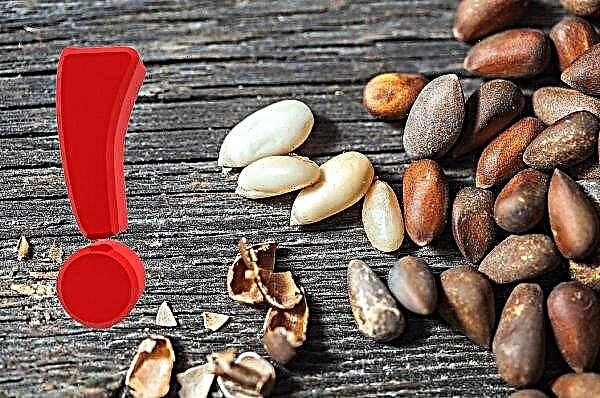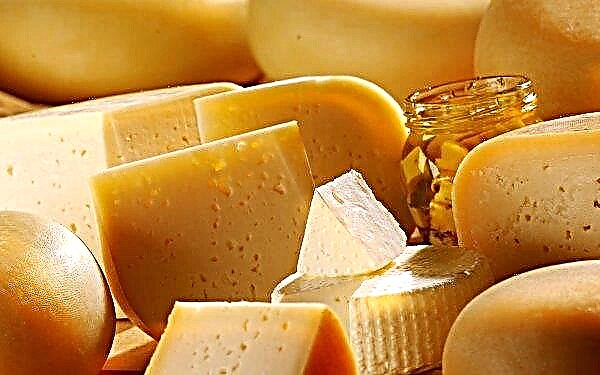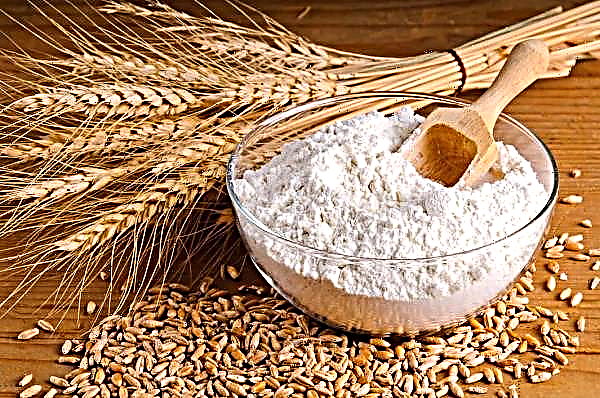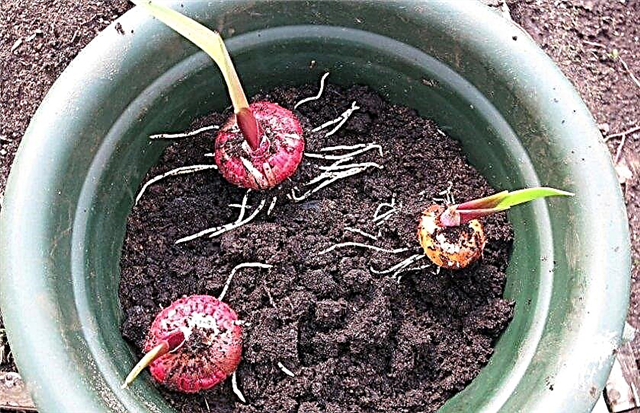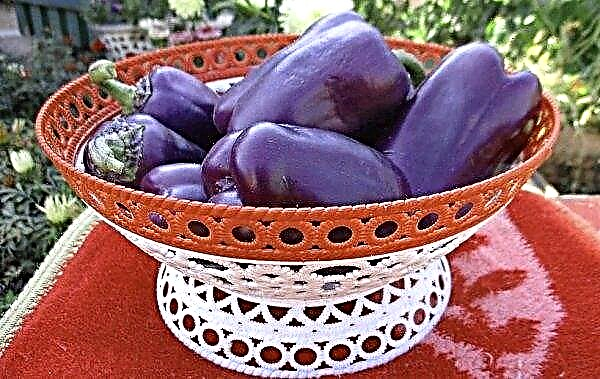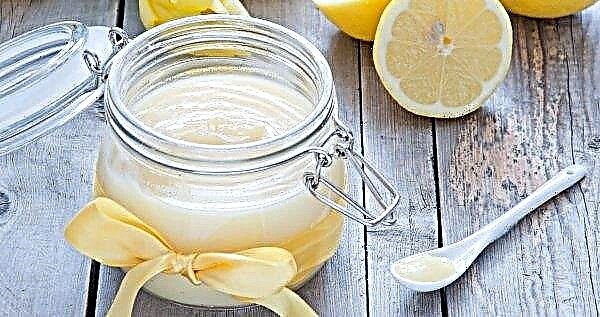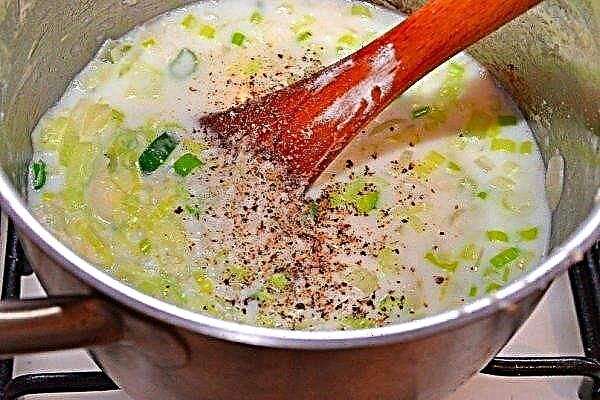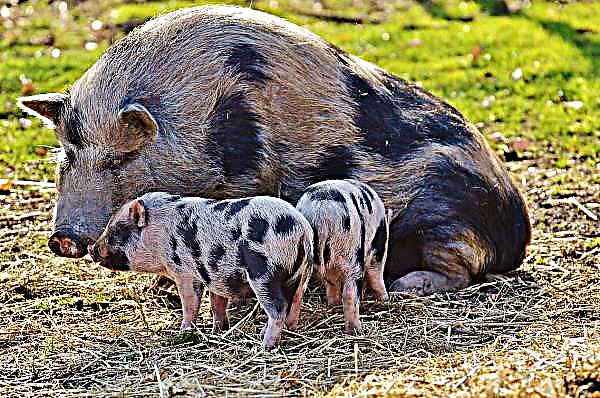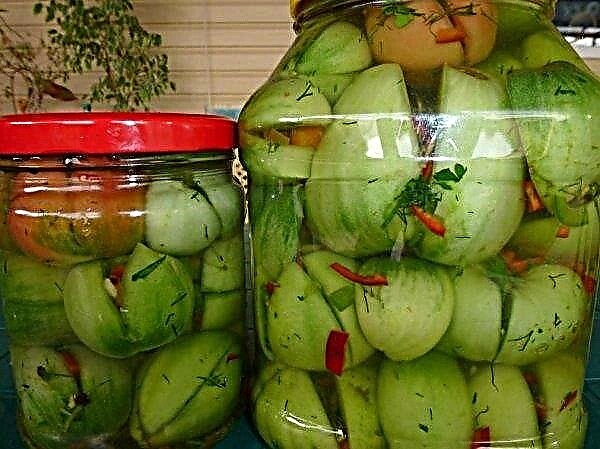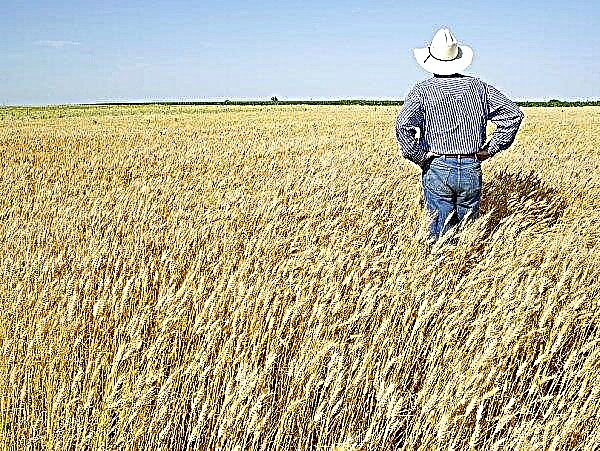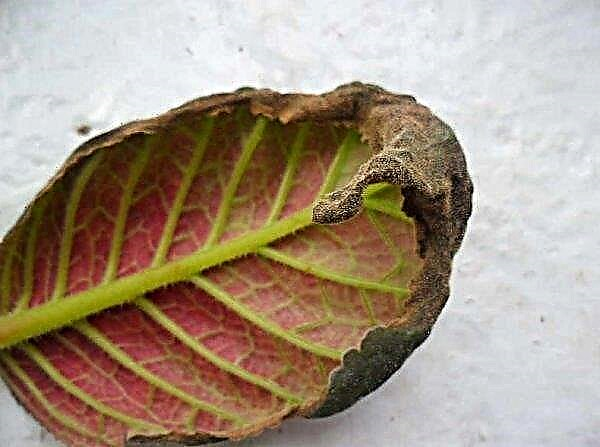Despite the fact that not everyone likes pumpkin, its rich vitamin composition is especially appreciated in the cold season, when there are no other fresh vegetables. To prepare a healthy and tasty dish, you should choose only sweet varieties of plants, one of which is Vitamin. What is remarkable about these fruits and how to grow them properly - this will be discussed in this article.
Grade characteristics
Vitamin - a late ripe pumpkin variety, since from the moment of emergence of the shoots and until the harvest takes at least 125-130 days. Outwardly, these are medium-sized plants with lashes up to 6 m long and pentagonal, gray-green leaves, with small white spots on the venation. Petioles of leaf plates reach 25 cm, which makes leaves even more noticeable. The emerging pumpkin has a short oval or short cylindrical shape, with a wide base. The surface of the vegetable is divided into segments and has a slight ribbing in the area of the stalk (sometimes it reaches almost the middle of the pumpkin).
Did you know? According to approximate estimates of archaeologists, the oldest pumpkin seeds found by scientists in Mexico are at least 7000 years old, which means that this plant has been used by people for personal purposes for a long time.
The background color of the vegetable at the beginning of development is dark pink, with a slight orange tint, but when the fruit ripens, it changes to brownish-brown with a pinkish tinge. A peculiar pattern in the form of a dark green or green grid with large or small elongated spots is applied on top of the main background, the color is slightly lighter than the main background. The skin is thin, the flesh is crispy, sweet or slightly sweet, reaches a thickness of 10 cm. The average weight of the fruit is 4.5–6.8 kg.
Advantages and disadvantages
- Vitamin Pumpkin really has a lot of advantages, which are primarily expressed in the following characteristics:
- good germination of the seed material, and it doesn’t matter if you prepared the seeds yourself or bought in a store;
- rapid rooting of transplanted seedlings in open soil;
- uniform spreading of lashes of vegetables on the surface of the earth;
- good resistance to diseases, pests and weeds that cannot drown out crop growth;
- high yield, because only three seedlings really get at least 9 pumpkins;
- excellent taste;
- universality of application;
- excellent keeping quality and preservation of all properties even during long-term storage.
As for the shortcomings, the most noticeable of them will be the late ripening of the fruits, but after waiting for their consumer maturity, you will definitely be satisfied with the result of the efforts made.
Features of planting and cultivating varieties
The pumpkin of the described variety is usually grown in seedlings, although there are cases of direct sowing in open soil (more typical for the southern regions). Each of the options has its own characteristic features, advantages and disadvantages, therefore, before making a final decision, it is worth considering all the nuances: starting from preparatory measures and ending with placing seeds in a substrate.
Suitable conditions
Germination of pumpkin seeds is possible at a temperature of at least + 11 ° C, therefore, sowing seeds in an open area, it is important to make sure that there are no freezing frosts and sufficient heating of not only soil, but also air (well, if the temperature in the street is stably kept within + 15 ... + 18 ° C or higher). Humidity is not so significant, although it is desirable that these indicators are not too low (the best option for air is not lower than 60–70%).
Moisture in the soil when sowing seeds should not impede its friability, but otherwise, sufficient moisture for sandy or light loamy substrates will benefit the culture. Immediately after sowing the seed, the lighting should be bright, lasting at least 6-7 hours a day, and after the appearance of young sprouts, its intensity can be reduced: instead of direct sunlight, plants can be illuminated with diffused light.
Soil and seed preparation
Preparatory measures are the first step on the path to successful cultivation of Vitamin Pumpkin, however, right after you decide on the method of planting the plant. Regardless of where the seeds are sown (seedlings or an open bed), seed preparation is always the same:
Regardless of where the seeds are sown (seedlings or an open bed), seed preparation is always the same:
- To begin with, for two months, pumpkin seeds are heated next to the heater (this will allow you to get more female seeds).
- Then, it is checked for germination by soaking in saline (the seeds that emerge on the surface are discarded, and the seeds that have settled on the bottom are used for planting).
- After selection, soak in a weak solution of potassium permanganate for at least 10 hours, changing the liquid at least once.
- The final step in the preparation of pumpkin seeds will be their hardening by wrapping in a damp cloth, with further placement in the refrigerator for three days.
Preparation of soil for planting a pumpkin depends on its type: indoor or outdoor. When growing seedlings, a substrate prepared from two parts of transition peat, one part of overripe wood sawdust and the same amount of humus is poured into the boxes. In the finished mixture, you can add a teaspoon of nitroammophoski, per 5 kg of substrate. Before planting the pumpkin directly, you only need to moisten the ground and you can deepen the seeds.
Important! When placing seeds in the refrigerator, leave them only on the lower shelves and never place them in the freezer. Frozen seeds will not be highly germinated.
If we are talking about planting pumpkin seeds immediately on a bed (in open soil), then you will have to start preparing the selected site since the fall: cleaning the soil from weeds, removing plant residues of cultivated varieties, digging and loosening the soil. Upon completion of the harvesting work, the earth should be fertilized with organic matter (for example, 3-5 kg of manure or compost per 1 m²) and, if necessary, add 200-300 g of ash or lime to it, which is important on heavy or overly acidic soils. With the advent of spring, the bed is fluffed up, the remaining weeds are harvested and dug to a depth of about 20 cm. Before directly sowing the pumpkins, you just need to level the territory and arrange holes for seedlings or furrows for seeds.
Upon completion of the harvesting work, the earth should be fertilized with organic matter (for example, 3-5 kg of manure or compost per 1 m²) and, if necessary, add 200-300 g of ash or lime to it, which is important on heavy or overly acidic soils. With the advent of spring, the bed is fluffed up, the remaining weeds are harvested and dug to a depth of about 20 cm. Before directly sowing the pumpkins, you just need to level the territory and arrange holes for seedlings or furrows for seeds.
Planting seeds
Depending on the chosen option for growing Vitamin pumpkin, an appropriate scheme and technology for sowing seeds is selected, so we will consider each option more closely.
Did you know? The largest pumpkin, which fell into the Guinness Book of Records, was grown in 2016 by the Belgian farmer Matthias Vilemayn and weighed 1190 kg.
In open ground
The scheme for sowing pumpkin seeds on the bed provides for their placement in rows, with a free space of 2 m (both between plants and between rows). 2-3 seeds are placed in each well, and after germination, weak specimens are removed, leaving only strong shoots. A distance of 2-3 cm is kept between the seeds in the hole, deepening the seed into the soil by at least 10 cm. At the end of the planting, the planted seeds can be additionally mulched with peat or manure, which will help to maintain sufficient moisture and protect the pumpkin from the cold. In the southern regions, the Vitamin variety is sown in the garden already at the end of May, but in the central or especially the northern regions, it is worthwhile to wait until the beginning or even mid-June.
At the end of the planting, the planted seeds can be additionally mulched with peat or manure, which will help to maintain sufficient moisture and protect the pumpkin from the cold. In the southern regions, the Vitamin variety is sown in the garden already at the end of May, but in the central or especially the northern regions, it is worthwhile to wait until the beginning or even mid-June.
In pots for seedlings
At home, sowing seeds of pumpkin seeds for seedlings is often performed already in early April, since it is much easier to keep the temperature ideal for seedlings indoors. As pots, any pots or disposable cups can be used, but it is easiest to grow pumpkin in special boxes divided by partitions into several separate cells. Before planting pumpkins, any reservoir is filled with the prepared soil mixture, but only half, so that after 10 days, when the growth of the stem part is slightly slowed down, it is possible to top up the soil to the level of cotyledon leaves.
The depth of seed placement in the pots is 2 cm, and it is advisable to leave at least 3-4 cm of free space between adjacent seeds. After planting the seeds in moist soil, it remains only to cover the plantings with a film and wait for the emergence of young plants, which are later planted on the garden. Care of the cultivated seedlings is based on timely moistening of the soil in the boxes, regular ventilation, especially at the first time when the plants are under film shelter and maintain optimal temperatures (in the first three days, seedlings are kept at + 25 ... + 30 ° С, and for two weeks before transplantation, lower the temperature to +14 ... + 16 ° C). When placing seedlings, it is worth giving preference to the southern sides of the apartment, because a sufficient amount of heat and light will contribute to the emergence of young plants in 3-4 days. After another 2.5 weeks, the seedlings will turn into strong and squat plants, with short internodes and three real, bright green leaves. Pumpkin seedlings do not need picking, therefore, two weeks after seed germination, you can carry out the first feeding using diluted mullein (1:10) or nitrophoska, 100 ml of solution for each plant.
When placing seedlings, it is worth giving preference to the southern sides of the apartment, because a sufficient amount of heat and light will contribute to the emergence of young plants in 3-4 days. After another 2.5 weeks, the seedlings will turn into strong and squat plants, with short internodes and three real, bright green leaves. Pumpkin seedlings do not need picking, therefore, two weeks after seed germination, you can carry out the first feeding using diluted mullein (1:10) or nitrophoska, 100 ml of solution for each plant.
In order not to burn the delicate root system of young plants, it is useful to combine top dressing with the next watering. On average, the grown Vitaminnaya pumpkin seedlings are transplanted to an open bed no earlier than 25 days after sowing the seeds, but even in this case it is worth organizing an additional film shelter. 5-10 days before the procedure, the seedlings begin to harden, leaving during the day at + 16ºC, and at night, reducing the temperature to + 13ºC. Such preparation will strengthen the plants, and they will not die under sharp temperature drops in the open ground.
Important! The layer of mulch should not exceed 2-3 cm, especially when it comes to sowing seeds (it will be difficult for thin shoots to break through a thick layer).
The technology of planting seedlings on the beds is not very complicated and provides for the implementation of several simple steps:
- Organization of holes (between adjacent plants should remain at least 1.5–2 m of free space).
- Humidification of the soil with hot water, per 2 l per plant.
- Planting seedlings in holes and seeding with soil so that the root neck is completely closed.
- Mulching with manure or peat.

Pumpkin Care Features
After sowing seeds or planting seedlings on a bed, a long process of caring for it begins. First of all, you should pay attention to the organization of irrigation and top dressing, although you should not forget about caring for the soil, which includes loosening the soil and removing weeds. Special attention should be paid to the formation of the bush, which will only increase productivity.
Watering and feeding
Vitamin Pumpkin is a drought-tolerant plant, however, at low air humidity it must be watered, bringing the liquid strictly under the root so that it does not get on the whip. Here, well-protected water, slightly heated by sunlight. Fertilizing pumpkin is no less important, of course, if you want to get a plentiful harvest of juicy fruits.
For the most effective result, there is even a certain feeding scheme:
- First time fertilizer bring in a week after transplanting seedlings to a constant place of growth, using diluted chicken droppings, additionally mixed with water in a ratio of 1: 4.
- The second and subsequent feeding carried out with regularity once a month and a half, until the ovaries appear on the plant. In order not to over-saturate the soil with nitrogen, it is worth alternating manure with a solution of wood ash or garden mix (50 g of dry matter per 10 liters of water).
 In cold summers, the pumpkin is additionally sprayed with a solution of urea, in a ratio of 10 g of substance per 10 liters of water, and when growing pumpkins on acidified soils, you can simply scatter ash on the soil surface and water the plot.
In cold summers, the pumpkin is additionally sprayed with a solution of urea, in a ratio of 10 g of substance per 10 liters of water, and when growing pumpkins on acidified soils, you can simply scatter ash on the soil surface and water the plot.Weeding and loosening the soil
Soil treatment is carried out shortly after watering, when it is easiest to seize weeds and loosen the substrate. If lateral tendrils appeared on the scourges, they must be dug into the ground and watered without moving or cutting the entire stem. At the end of the soil treatment, it is mulched with straw or humus, with which it is possible to retain moisture and prevent the growth of weeds.
Important! In order not to damage the root system of strong shoots, it is not recommended to pull out the plants. It is better to cut them at the level of the soil, leaving the roots in the ground.
Plantings are thinned out only after the first seedlings appear: from 3-4 plants that appeared after direct sowing of seeds into the soil, only 1 or 2 of the strongest seedlings are left.
Bush formation
Many gardeners do not form pumpkin bushes in any way, however, when growing the Vitamin variety, it is still useful to pinch the side lashes and the main stem. This simple procedure is performed after the shoots reach a length of 1.5–2 m and form a sufficient number of fruit ovaries.
As the fruit grows, it is worthwhile to place a sheet of plywood or polystyrene under them, which will protect the pumpkins from decay. Do not remove all weaving side stems attached to the soil with the help of antennae, since it is with their help that the plant receives all the necessary nutrients.
Video: Pumpkin Formation
Pest and Disease Control
When growing pumpkins of the Vitamin variety, gardeners may encounter the following problems, which, by the way, are also characteristic of other varieties of the nutmeg group of this crop:
- Bacteriosis - characterized by the appearance of brownish spots on the seed of the plant, which over time grow and turn into ulcers that change the shape of the fetus. With high humidity, the disease spreads in a matter of days and can destroy most of the crop. To protect the fruit, damaged specimens should be removed immediately, and the remaining ones should be treated with a solution of Bordeaux mixture or copper chloroxide.
- Root rot - manifests itself in the yellowing of the leaf plates of the pumpkin and the halt of its growth, the main reason for which is the fungus. It quickly spreads over the bed during prolonged rains and high humidity, affecting mainly weakened plants. You can get rid of the problem with the help of the Previkur drug, which sprayed all parts of the culture. The stem should be sprinkled with soil (thus, additional roots are formed), fertilized with a mixture of copper sulfate and zinc sulfate, taken in equal proportions.
- White rot - Another fungal disease, the main symptom of which is the appearance of white spots on the leaves and shoots of the culture. As in the previous case, the damaged parts must be disposed of, and the remaining parts should be treated with a solution of zinc sulfate and copper sulfate.
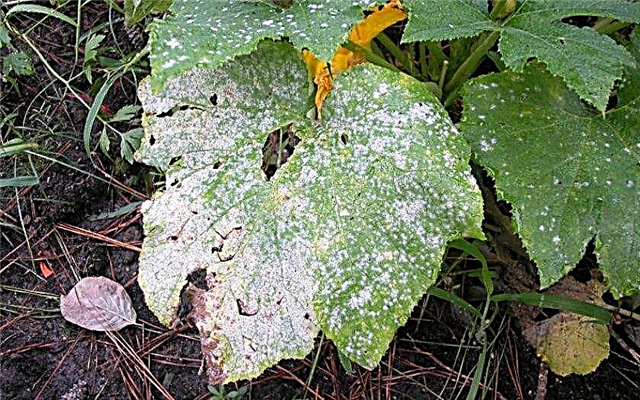
- Spider mite - A frequent guest in any garden that damages a wide variety of cultures. If you do not detect the pest in time, almost all the leaves of the pumpkin will become marble and quickly turn yellow. Spider mites are very fond of high temperatures and insufficient soil moisture, so in order to prevent a problem, you will have to regularly moisten the beds and spray the stems and leaves of plants with plain water.Ground sulfur, isophene and kalten combined with water in accordance with the instructions will be effective in controlling insects.
- Gourd aphids - lives on the bottom of pumpkin leaves and on the ovaries of the plant. Small insects suck out all the juices from the tissues, which is why the stems wither and die off soon. In this case, for processing the culture, you can use the drug "Karbofos", which is sprayed with the plant several times, with an interval of 10 days.

In order to prevent the occurrence of such problems in the future, it is important to comply with crop rotation requirements (cabbage, carrots, tomatoes are considered undesirable precursors for pumpkins), and to remove weeds and affected parts of other crops in a timely manner. In addition, do not forget about the rules of agricultural technology: for example, watering pumpkins should always be moderate, since the spread of fungal diseases in waterlogged soil occurs much faster.
Important! Chemical treatment of plants can be carried out no later than two weeks before the proposed harvest.
Harvest Dates
If the pumpkin seedlings of the Vitaminovaya variety were planted in early June, then it will be possible to collect the fruits from the second half of September or at the beginning of October, after the onset of biological maturity of pumpkins. Determine the most suitable time will help the appearance of a clear pattern on the hardened skin of the fruit and the dried stalk of the plant. Harvest preferably on a clear and dry day, before the first frost.
Pumpkins are cut with the stalk, and then sorted by size and quality. Damaged or not fully ripened specimens are best processed immediately for conservation, but whole and ripe fruits after additional drying in the room can be stored all winter. To dry the pumpkins, they are left in the sun for one or two weeks, and as soon as the stalks are tucked and hardened, the bark is removed into the cellar. Before the cold, you can store the collected fruits on the balcony, but as soon as the air temperature drops below + 5 ° C and remains at this level, it is worth moving the crop to a warmer place. Sometimes it is buried right in the garden, after arranging a suitable trench and laying its bottom with a thick straw layer. So that the pumpkins do not fade, ventilation holes must be arranged from different sides of the masonry. With good care and suitable growing conditions, nutmeg pumpkin is characterized by a relatively high yield - up to 4.4 kg per 1 m² of plantings.
Before the cold, you can store the collected fruits on the balcony, but as soon as the air temperature drops below + 5 ° C and remains at this level, it is worth moving the crop to a warmer place. Sometimes it is buried right in the garden, after arranging a suitable trench and laying its bottom with a thick straw layer. So that the pumpkins do not fade, ventilation holes must be arranged from different sides of the masonry. With good care and suitable growing conditions, nutmeg pumpkin is characterized by a relatively high yield - up to 4.4 kg per 1 m² of plantings.
Recommendations for use
Vitamin variety is great for preparing various dishes or processing into blanks. Due to the high content of carotene and sugar in ripe fruits, they can be used for organizing baby food and making therapeutic diets. The pulp of pumpkin is successfully used for juice, mashed potatoes, baking and various vitamin dishes. The high palatability of these fruits allows you to use them even in their raw form, especially since in this way all the useful properties of the vegetable are preserved in full.
So, raw or properly cooked pumpkin can have a beneficial effect on the human body, which consists in:
- strengthening the stomach and intestines;
- vision improvement;
- strengthening the body's immune forces;
- accelerating the regenerative processes of the body;
- strengthening the reproductive system;
- elimination of puffiness.
 Regular consumption of pumpkin (in particular, Vitamin variety) is also able to improve the psychological mood, however, only if we are talking about a quality product grown in accordance with all agrotechnical requirements. Quality crop care will provide you with a healthy harvest for a long time.
Regular consumption of pumpkin (in particular, Vitamin variety) is also able to improve the psychological mood, however, only if we are talking about a quality product grown in accordance with all agrotechnical requirements. Quality crop care will provide you with a healthy harvest for a long time.



